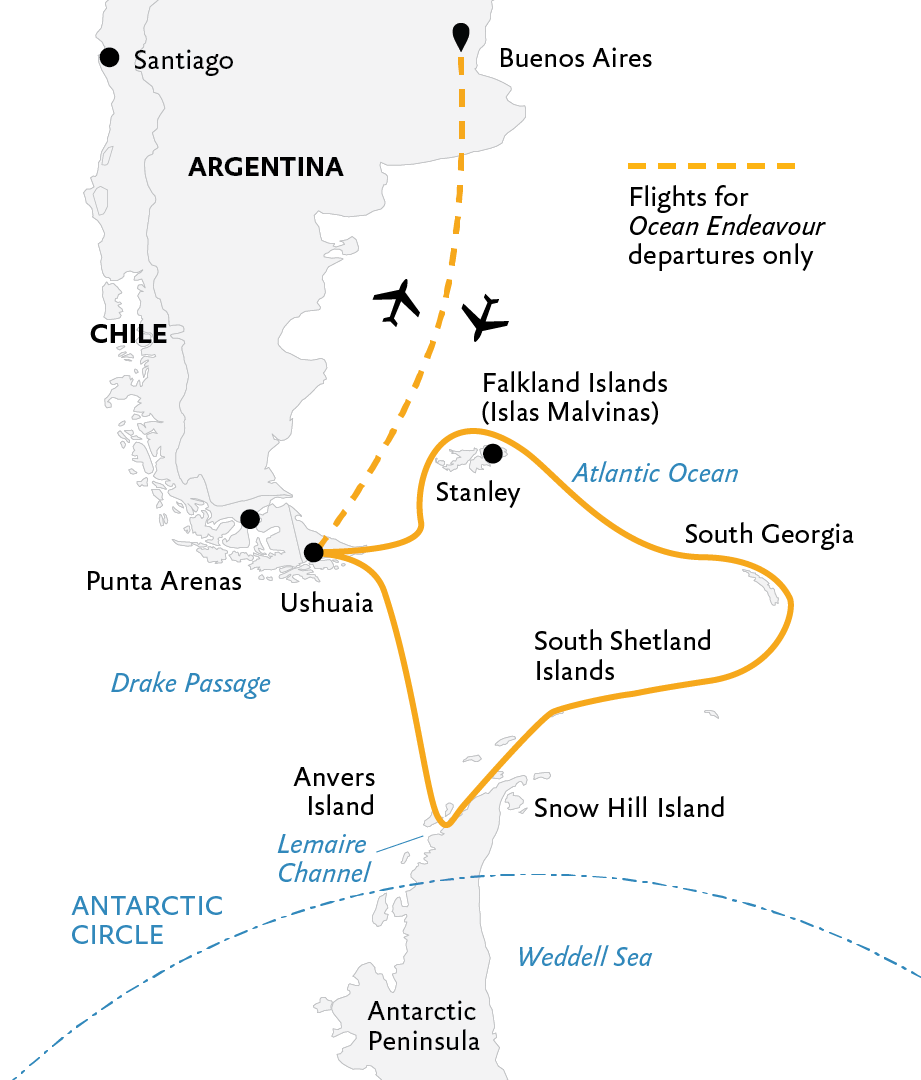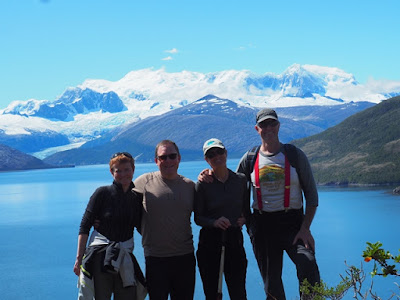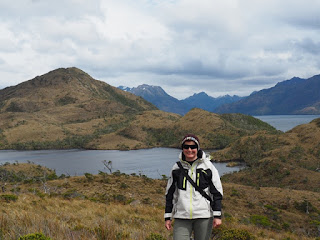We arrived in Puerto Williams, at 54o56’ South (also known as the END OF THE WORLD) at ~2 am on Sunday, February 9th. Why so late (or early) in the day? And why a night arrival, you may ask?
 |
| Entrance to the Beagle Channel... We have arrived. |
It all started on Friday morning. We left our wonderful anchorage at the base of a glacier early with the intention of having a leisurely sail/motor 20 nm south to an anchorage known for its spectacular hiking. I wanted to get there early so that we’d have the day to do at least one of the hikes described in the guidebook. The sun was shining and it was a beautiful day so we were looking forward to an afternoon walking in the hills.
 |
| Climate change IS Happening! |
As there wasn’t much wind we motored along happily, making water and running the heaters to dry Gary’s wet hiking boots (more on that in another post). I was down in the cabin working when Gary took a radio call from a Dutch sailboat 10 nm ahead. Their engine wasn’t working and so they requested a tow to the anchorage we were heading to as there was no wind for them to sail. They had seen us on the AIS and we were the only boat going in this direction. As the Laws of the Sea demand, we said yes, of course we would tow them. What else could we do?
 |
| Earning serious boat Karma |
It look us a few hours to make our way down the channel to their location, and thankfully the 10 knot headwind we’d been battling died a mile from where they were floating. We drove up alongside their boat, introduced ourselves briefly, took their tow line and secured it to Sea Rover II. We then towed them along at 3.5 knots for the next three hours until we reached the anchorage 10 nm away. As it was a calm day, this was easy and everything went smoothly. At the mouth of the anchorage we dropped the tow line and they limped into the cove using their 2 horsepower outboard engine, which was strapped to the back of their boat. They anchored and all was well. It was now 4pm in the afternoon so my plans for hiking went out the window.
 |
| Views upon views.. We have soooo many pictures like this. |
They invited us over for a drink to thank us for the tow. After a quick inspection of the engine it became clear that their issue wouldn’t be an easy fix and would likely require getting parts in Ushuaia, 30 nm away from where we were anchored. As Saturday was forecast to be windless and calm, we offered to tow them there. Another Cruiser who spoke Spanish talked to the Armada (Chilean Navy, who also act as the de facto Coast Guard) and arranged to have us stop at Puerto Navarino on the Chilean side of the Beagle Channel, directly across from Ushuaia, so that we could all clear out of the country. Clearing out of Chile is required before you can enter another country so this in an important formality. The plan was to anchor in Navarino, complete the paperwork, stay overnight and then tow them the 9 nm across the channel to Ushuaia on the Argentinian side the next morning. Puerto Navarino is not an official port where country clear out procedures happen, and so it seemed that they were making an exception for this disabled boat.
 |
| Very early departure from Caleta Olla. Ushuaia here we come! |
We agreed to leave at first light on Saturday morning as we knew we had a long day ahead, so by 6am we had them under tow out of the anchorage. The conditions were sunny and calm all morning. The cockpit got so warm that we actually took off our foul weather gear for the first time this season! I think we even got a sunburn.
 |
| Beagle Channel... Scariest place to sail in the world... Really??? |
After consulting the weather and seeing that the winds were forecast to be quite strong on Sunday, which would make it difficult to tow them safely, I contacted the Chilean Navy to ask for permission to transit directly to Ushuaia without stopping in Puerto Navarino. They told us to stand by, but came back with a firm no, we needed to clear out in Navarino. So, into “port” we went. I put “port” in quotations as the town consists of the Armada building and nothing else. Just outside the bay we pulled the Dutch boat alongside and anchored with them attached to our side. We then launched the dinghy and went in to the office to begin the clear out procedure.
 |
| Yup... They are still attached. Sadly we aren't going to Ushuaia... |
The officer on duty was very junior, but he remembered me from our (painful) radio conversation about trying to bypass Navarino. He understood our concerns about the wind and went away to make a call. He came back 5 minutes later and told us we had two options. 1) We could take a car to Puerto Williams, a 50 km drive on a bumpy gravel road, to clear out there, or 2) we could take our boats to Puerto Williams, a 25 nm (50km) motor down the Beagle Channel to clear out there. Hmmm, not quite what we expected. We pointed out that we’d arrived in boats and so didn’t have a car to make option 1 a reality. Did he know a way we could get there? He repeated that we had 2 options… and no, the Armada could not arrange a car for us. It was not his problem (which, in fairness, it wasn’t). After letting the disappointment sink in, we started discussing options. Leaving the Dutch in Puerto Navarino wasn’t really an option as the anchorage is not protected from the north and the winds were forecast to come from that direction on Sunday. As we had 6 hours of daylight left and it was ‘only’ another 25 nm to Puerto Williams, we made the fateful decision to tow them there that evening. If the conditions stayed as they had been all day, this would have been easily accomplished. Alas, it was not meant to be.
 |
| Surprisingly we have no pictures of when it got ugly... You'll just have to trust us. |
The wind picked up an hour into the trip to 15-20 knots directly on the nose, and the seas picked up along with it. Pretty soon we were bashing into 1.5 metre seas with the Dutch boat bashing along 100 feet behind us. As the wind built, our speed decreased until we were making 1.5 knots speed-over-ground. At least we weren’t going backwards! As this wasn’t comfortable for us or the poor Dutch, we decided to try to pull into a bay that looked like it might offer some protection on the charts. Unfortunately it was too deep to anchor in the open area of the bay, and the only possible anchor location required a tight entry between several rock-strewn areas marked by kelp. As our maneuverability with the Dutch attached behind was poor even without accounting for the strong wind, we decided it was safer to slog along at 1.5 knots towards Puerto Williams instead of risking getting close to shoals and rocks. Out we went back into the seas. At this point Gary and I resigned ourselves to a long night. We did discuss turning around and heading back to Puerto Navarino, but this would have required a night entry in an area full of unmarked reefs and shoals. It was challenging enough during the day in calm seas and neither of us could imagine trying it in the dark. With no good options, we hoisted our mainsail and motor-sailed slowly up the channel. Thankfully the winds died down as the sun set and the seas decreased along with them. Pretty soon we were back to pulling them along at 3.5 knots in calm conditions. A night arrival into Puerto Williams was now inevitable, but the bay is large and the Dutch knew the area well.
 |
| If it looks like this... Don't try to go into the harbour no matter what they tell you. |
We arrived in the big bay off of Puerto Williams at 0100 and then made a mistake. Instead of just anchoring off the town and waiting for daylight to go into the protected inlet where the marina is located, we listened to the Dutch when they said the entry to the inlet was easy and we’d have lots of room to maneuver inside. Despite our unvoiced, individual misgivings, we pulled them alongside and headed to the mouth of the inlet. Even with the brightness of the full moon, it quickly became clear that we couldn’t identify enough landmarks in the dark to enter the inlet safely. After we found ourselves in the middle of a kelp field and the depth sounder got down to 0.1 m beneath our keel, we slowly backed up (no easy feat with a 40 foot sailboat strapped to our side!) and moved back out into the bay. I’m pretty sure I taught the Dutch a few new swear words during the whole procedure. Phew. We dodged a bullet. By the time we were anchored it was 0230 and we were exhausted. We fell into an exhausted sleep only to be awakened by the Navy at 7 am calling to tell us we needed to move as we were anchored off the end of the runway for the airport and they were expecting a plane… Oops.
 |
| Really... We promise... It did get rough... |
The story, of course, ends well. We towed the Dutch boat 70 nm down the Beagle Channel to Puerto Williams, where they are hopeful that the local mechanic will be able to fix their engine; we got here safely and made some new friends. In Puerto Williams we immediately met up with our friend Rene on sv Ata Ata, a single-handed sailor we met when we first arrived in Valdivia 2 years ago. He made us a lovely dinner our first night in town, and we enjoyed another lovely meal at a fantastic pizza restaurant in town with the Dutch last night. We feel spoiled!
We officially cleared out of Chile yesterday and headed back up the Beagle Channel 25 nm to Ushuaia in Argentina today. It’s a bit rough in the marina where we are currently moored as we are rafted 4 boats deep off a big wharf in a pretty exposed harbor, but it’s OK. We’ll stay for a few days, then return to Puerto Williams on the weekend and re-check into Chile so that we can start the clock on our temporary boat import permit again, which is the whole reason we sailed down here in the first place.
So we made it to the THE END OF THE WORLD. But what happened to the middle? As we didn’t write much about our travels within the Patagonian Channels on the way down, we’ll spend the next few blog posts going back in time and filling in some of the gaps (with pictures, of course).






















































